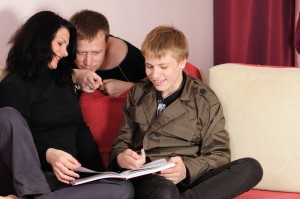
Anxiety disorders, such as generalised anxiety disorder (GAD), social anxiety, panic disorder and phobias, are common and affect between 5 – 19% of all children and adolescents (Costello, 2004; as cited in James et al, 2013, pg. 6). Anxiety problems in childhood or adolescence can disrupt social and educational life, and may persist into adulthood.
Cognitive Behavioural Therapy (CBT) is a form of psychological therapy often used in the treatment of anxiety. It is a collaborative process which can be delivered in family, group or one-to-one settings, and is often preferred as a first-line treatment before introducing anxiolytic medication (James et al, 2013, pg. 6). A previous Cochrane review – James et al (2005) – found that CBT is an effective treatment for anxiety in children and adolescents, with 56% of cases meeting criteria for remission.
But for James and colleagues one review was simply not enough. They still had many questions they wanted answered. Such as:
- How does CBT compare to waiting list, “active control” treatments or treatment as usual for children and adolescents with anxiety?
- Are the benefits of this CBT maintained at follow-up?
- Does the format (individual, group, parent/family) make a difference?
- How effective is CBT compared to medication, placebo or a combination of CBT and medication?
And so, they wrote another Cochrane review to answer these: James et al (2013).
Methods

In children and adolescents, CBT for anxiety focuses on teaching them to recognise their physical and mental reactions to anxiety.
James et al used trial registers, journals, reference lists, personal communication and book chapters to search for relevant studies. They selected RCTs which used participants in the correct age range, with any DSM or ICD diagnosis of anxiety (excluding: simple phobia, OCD, PTSD and elective mutism) which assessed CBT in comparison to waiting list, active controls, treatment as usual (TAU) or medication. Active control treatments included psycho-education, bibliotherapy and therapist/peer support. TAU included family therapy, play therapy, supportive psychotherapy, psychodynamic psychotherapy and non-CBT eclectic approaches.
Selected studies were assessed by the authors and data extracted from the most appropriate papers. This resulted in 41 studies comprising over 1800 participants.
The outcome measures analysed to assess the review’s aims and objectives were as follows:
- Primary:
- Remission – the patient no longer meets criteria for the anxiety disorder. As assessed by clinical interview by someone outside of the treatment team, or by the Clinical Global Impression scale (CGI-I).
- Acceptability – judged by the number of participants who did not complete the study.
- Secondary:
- Reduction in anxiety symptoms – the severity of the anxiety, as measured by psychometric scales, has shown clinical improvement – even if the patient still meets criteria for having an anxiety diagnosis.
Results

There was not enough evidence to examine how CBT affects anxiety in young people at long-term follow-up; nor to compare it with medication.
These are the answers they found to their questions:
- How does CBT compare to waiting list, “active control” treatments or treatment as usual for children and adolescents with anxiety?
- Waiting list:
- Remission: CBT (in any format: family, individual, etc.) showed significantly higher rates of remission than waiting list controls (59.4% vs. 17.5%).
- Acceptability: CBT (in any format) had an equal level of drop outs to the waiting list.
- Active controls:
- No statistical difference was found between rate of remission and reduction of symptoms between CBT and active control treatments.
- Acceptability: CBT was found to have significantly lower drop-out rates than active control treatments.
- Treatment as usual:
- No significant differences were found between CBT and TAU in terms of remission, reduction of symptoms or acceptability.
- Waiting list:
- Are the benefits of this CBT maintained at follow-up?
- Waiting list: no significant differences between CBT and waiting list in either rate of remission or reduction of symptoms.
- Active control treatments: CBT was found to have significantly higher rates of remission, and equivalent reduction of anxiety symptoms at follow up.
- There was no data available to compare CBT to TAU.
- Does the format (individual, group, parent/family) make a difference?
- Remission: there was no difference in remission measures between individual, group and family CBT.
- Reduction of symptoms: group and family/parental CBT resulted in greater reduction of symptoms than individual CBT.
- How effective is CBT compared to medication, placebo or a combination of CBT and medication?
- Only one study was found addressing this question (Walkup, 2008), so meta-analysis was not possible.
Conclusions

Group and family/parental CBT resulted in greater reduction of anxiety symptoms than individual CBT.
What can we conclude from all this? There are a lot of findings and sub-analyses to get to grips with.
The bigger picture is that CBT is significantly more effective than doing nothing (waiting list), and equally as effective as “treatment as usual” and other active treatments – these included non-CBT psychotherapies, guided self-help, psycho-education or peer support. The authors concluded that CBT can be recommended clinically.
There is also some interesting detail to take note of: firstly, there is no clear winner when it comes to the format that CBT should take (i.e. group vs. individual), although there is some evidence that in terms of symptom reduction, group and family formats may have more success. In studies comparing CBT and active control therapies, there was significantly less drop-out of participants in the CBT arms.
There was not enough evidence to reliably examine how CBT affects anxiety in young people at long-term follow-up; nor to compare it with medication or see how effective it is in combination with medication. This highlights one of the key problems found by James et al. They state that the number of studies for examining follow-up effects is extremely limited, with analyses consisting of just three or four studies. You don’t have to be an elf to notice that “three or four” isn’t very many! The situation is even worse when it comes to examining CBT in contrast or combination with medication: there was only one study available, meaning that meta-analysis could not be carried out. Unsurprisingly, James et al conclude their review by calling for further research in these areas, and also for researchers to adhere to CONSORT guidelines and be more clear in describing their randomisation processes.
By no means is this review filled with doom and gloom, however. The overall quality of the research analysed was moderate, and there seems to have been an increase in research in this area since James et al (2005). What’s more, the research carried out since then has improved the generalizability of findings in the field: now there is research from inner city schools as well as community clinics, carried out by both specialist and non-specialist therapists. (Elf note: only mild to moderate severity was included, however, so the results can’t be generalized to inpatient populations).
Maybe the next time James et al fancy writing another Cochrane review, they’ll be delighted to find plenty of shiny new RCTs looking at long-term effects of CBT, comparing it to medication, and remembering to tell everyone how they randomised their participants. Let’s keep our fingers crossed!
Links
James, A.C., James, G., Cowdrey, F.A., Soler, A., & Choke, A. 2013. Cognitive behavioural therapy for anxiety disorders in children and adolescents (review). Cochrane Database of Systematic Reviews 2013, Issue 6. Art. No.: CD004690. DOI: 10.1002/14651858.CD004690.pub3. (PDF)


Cochrane review finds ‘solid’ evidence for CBT for anxiety in young people, but lacks evidence for long-term b… http://t.co/1vUVh33dUU
Check out @Mental_Elf blog post on #CochraneEvidence on #CBT for anxiety in young people http://t.co/h9TRwZ5BIR
Uncertainty about the long-term benefits of CBT for anxiety in young people, says @cochranecollab http://t.co/OlyYUZLi0v
@Mental_Elf @cochranecollab Isn’t uncertainty about long-term benefits of any medical intervention almost a rule?
@Mental_Elf @cochranecollab I prefer EmoTrance created by Silvia Hartmann, it’s easy for a child to learn and fast to use.
Cochrane review finds ‘solid’ evidence for CBT for anxiety in young people, but lacks evidence for long-term benefits http://t.co/ff3DjnomqR
Group and family/parental CBT results in greater reduction of anxiety symptoms in young people http://t.co/OlyYUZLi0v
@ECernis summarises a recent @cochranecollab review of CBT for anxiety disorders in children & adolescents http://t.co/OlyYUZLi0v
Do you have any information on the rate of children with anxiety disorder who fall into addiciton?
RT @ECernis: My latest post for @Mental_Elf: how effective is CBT for anxiety in young people? Better than other active treatment? http://t…
In case you missed it earlier: Cochrane review finds ‘solid’ evidence for CBT for anxiety in young people http://t.co/OlyYUZLi0v
RT @JaneStreetPPAD: @ECernis @WandsCYPIAPT @Mental_Elf how effective is CBT for anxiety in young people-better than other active treatmt? h…
Cochrane review finds ‘solid’ evidence for CBT for anxiety in young people, http://t.co/6gJWALWVpr via @sharethis
Mental Elf: Cochrane review finds ‘solid’ evidence for CBT for anxiety in young people, but lacks evidence for… http://t.co/ataYqZ2f2E
Yet *another* review of CBT fails to show long-term benefits http://t.co/S0jSwEQV7F via @sharethis